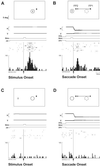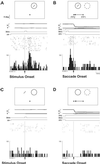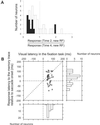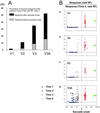Updating of the visual representation in monkey striate and extrastriate cortex during saccades
- PMID: 11904446
- PMCID: PMC122642
- DOI: 10.1073/pnas.052379899
Updating of the visual representation in monkey striate and extrastriate cortex during saccades
Abstract
Neurons in the lateral intraparietal area, frontal eye field, and superior colliculus exhibit a pattern of activity known as remapping. When a salient visual stimulus is presented shortly before a saccade, the representation of that stimulus is updated, or remapped, at the time of the eye movement. This updating is presumably based on a corollary discharge of the eye movement command. To investigate whether visual areas also exhibit remapping, we recorded from single neurons in extrastriate and striate cortex while monkeys performed a saccade task. Around the time of the saccade, a visual stimulus was flashed either at the location occupied by the neuron's receptive field (RF) before the saccade (old RF) or at the location occupied by it after the saccade (new RF). More than half (52%) of V3A neurons responded to a stimulus flashed in the new RF even though the stimulus had already disappeared before the saccade. These neurons responded to a trace of the flashed stimulus brought into the RF by the saccade. In 16% of V3A neurons, remapped activity began even before saccade onset. Remapping also was observed at earlier stages of the visual hierarchy, including in areas V3 and V2. At these earlier stages, the proportion of neurons that exhibited remapping decreased, and the latency of remapped activity increased relative to saccade onset. Remapping was very rare in striate cortex. These results indicate that extrastriate visual areas are involved in the process of remapping.
Figures








References
-
- Hallett P E, Lightstone A D. Vision Res. 1976;16:107–114. - PubMed
-
- Mays L E, Sparks D L. J Neurophysiol. 1980;43:207–232. - PubMed
-
- Duhamel J R, Colby C L, Goldberg M E. Science. 1992;255:90–92. - PubMed
-
- Umeno M M, Goldberg M E. J Neurophysiol. 1997;78:1373–1383. - PubMed
-
- Walker M F, Fitzgibbon E J, Goldberg M E. J Neurophysiol. 1995;73:1988–2003. - PubMed
Publication types
MeSH terms
Grants and funding
LinkOut - more resources
Full Text Sources

